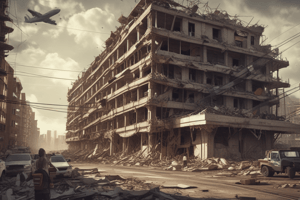Podcast
Questions and Answers
What level of training is required for all TFD fire companies regarding structural collapse?
What level of training is required for all TFD fire companies regarding structural collapse?
- Advanced functional level
- Technician level
- Awareness functional level (correct)
- Operational level
When should a technician level company be dispatched?
When should a technician level company be dispatched?
- When structural integrity is guaranteed
- When no victims are present
- To a scene where victims must be removed from a partially or completely collapsed structure (correct)
- For incidents without structural collapse
Why should Incident Commanders (ICs) exercise discretion in allowing crews into affected areas?
Why should Incident Commanders (ICs) exercise discretion in allowing crews into affected areas?
- To enforce traffic regulations
- To expedite the rescue process
- To maintain communication with victims
- To avoid potential secondary collapse (correct)
What should the first arriving company officer do upon arrival at a collapse scene?
What should the first arriving company officer do upon arrival at a collapse scene?
What is the primary concern for spotting apparatus at a structural collapse scene?
What is the primary concern for spotting apparatus at a structural collapse scene?
What is Level 1 or Level 2 staging meant to manage at a structural collapse scene?
What is Level 1 or Level 2 staging meant to manage at a structural collapse scene?
What should ICs assess immediately upon arrival at a collapse incident?
What should ICs assess immediately upon arrival at a collapse incident?
What types of resources should be considered early in response to a structural collapse?
What types of resources should be considered early in response to a structural collapse?
What is a key responsibility of Incident Commanders (ICs) in relation to structural collapse hazards?
What is a key responsibility of Incident Commanders (ICs) in relation to structural collapse hazards?
Which of the following is NOT a hazard associated with structural collapse?
Which of the following is NOT a hazard associated with structural collapse?
What action should be taken if securing all hazards is not feasible?
What action should be taken if securing all hazards is not feasible?
During the initial rescue phase, what is one of the primary focuses for the first arriving companies?
During the initial rescue phase, what is one of the primary focuses for the first arriving companies?
What is essential for the IC to establish quickly during structural collapse operations?
What is essential for the IC to establish quickly during structural collapse operations?
What is an important step for the IC regarding transportation during the operation?
What is an important step for the IC regarding transportation during the operation?
How should the IC respond to unorganized efforts by civilian personnel during a structural collapse?
How should the IC respond to unorganized efforts by civilian personnel during a structural collapse?
Which of the following best describes the need for scene control?
Which of the following best describes the need for scene control?
What is the primary function of the EMS Group/Branch in the context of a collapse incident?
What is the primary function of the EMS Group/Branch in the context of a collapse incident?
Why should all personnel, including civilians, be removed from the collapse site after initial surface victim removal?
Why should all personnel, including civilians, be removed from the collapse site after initial surface victim removal?
What immediate step should the IC take once all personnel have been removed from the collapse site?
What immediate step should the IC take once all personnel have been removed from the collapse site?
What specific guideline applies to operations that exceed the removal of surface trapped victims?
What specific guideline applies to operations that exceed the removal of surface trapped victims?
Which of the following actions is recommended if criminal activity may have caused the collapse?
Which of the following actions is recommended if criminal activity may have caused the collapse?
When explosives are suspected as the cause of a collapse, what should rescuers consider?
When explosives are suspected as the cause of a collapse, what should rescuers consider?
What is the main purpose of tracking victims from the collapsed area?
What is the main purpose of tracking victims from the collapsed area?
What should be occurring immediately following the establishment of the victim staging area?
What should be occurring immediately following the establishment of the victim staging area?
Before the IC or safety officer allow companies into a collapsed structure they should be properly assessed and ____
Before the IC or safety officer allow companies into a collapsed structure they should be properly assessed and ____
If additional resources are necessary, _____ staging should be established
If additional resources are necessary, _____ staging should be established
During the ____ stages of an operation the IC should maintain open roadways into an out of the collapse site. This may include establishing liaison with ___
During the ____ stages of an operation the IC should maintain open roadways into an out of the collapse site. This may include establishing liaison with ___
Flashcards
Awareness Level Response
Awareness Level Response
Fire companies trained to recognize and respond to structural collapse incidents but not perform rescue operations.
Technician Level Response
Technician Level Response
A specialized company equipped and trained to remove victims from collapsed structures.
Incident Commander (IC)
Incident Commander (IC)
The person in charge of a structural collapse incident.
Hazard Assessment
Hazard Assessment
Signup and view all the flashcards
Apparatus Placement
Apparatus Placement
Signup and view all the flashcards
Level 1 and Level 2 Staging
Level 1 and Level 2 Staging
Signup and view all the flashcards
Resource Assessment
Resource Assessment
Signup and view all the flashcards
Hazard Control
Hazard Control
Signup and view all the flashcards
Unmanageable Hazards
Unmanageable Hazards
Signup and view all the flashcards
Scene Perimeter
Scene Perimeter
Signup and view all the flashcards
Robust Command Structure
Robust Command Structure
Signup and view all the flashcards
Surface Victim Rescue
Surface Victim Rescue
Signup and view all the flashcards
Transportation and Victim Staging
Transportation and Victim Staging
Signup and view all the flashcards
Personnel Management Post-Incident
Personnel Management Post-Incident
Signup and view all the flashcards
Incident Action Plan (IAP)
Incident Action Plan (IAP)
Signup and view all the flashcards
Investigation and Criminal Activity
Investigation and Criminal Activity
Signup and view all the flashcards
Secondary Devices
Secondary Devices
Signup and view all the flashcards
First Arriving Officer
First Arriving Officer
Signup and view all the flashcards
Secondary Collapse
Secondary Collapse
Signup and view all the flashcards
Toxic Atmospheres
Toxic Atmospheres
Signup and view all the flashcards
Immediate Hazard Assessment
Immediate Hazard Assessment
Signup and view all the flashcards
Hazard Mitigation
Hazard Mitigation
Signup and view all the flashcards
Technician Level Resources
Technician Level Resources
Signup and view all the flashcards
Study Notes
Structural Collapse Response Guidelines
- TFD fire companies trained to operate at awareness level for structural collapse incidents.
- Technician level company dispatched for victim removal from collapsed structures.
- Incident Commanders (ICs) and safety officers must assess danger before allowing crews into compromised areas.
Tactical Considerations for Incident Command
- First arriving officer is responsible for establishing command and scene assessment.
- Apparatus must be positioned away from possible structural collapse; traffic conditions must be considered.
- Implement Level 1 or Level 2 staging for managing emergency and civilian traffic almost immediately.
- Assess additional resource needs promptly, including heavy equipment like cranes and loaders.
Hazard Assessment and Management
- Immediate hazard assessment should identify risks such as secondary collapse, explosions, debris, and toxic atmospheres.
- A crew must be assigned to secure hazards, which includes shutting off utilities whenever possible.
- Notify rescue personnel of any unmanageable hazards still present at the scene.
Scene Control Measures
- Establish a perimeter around the collapse site; restrict civilian access to prevent chaos and improve safety.
- Emphasize a robust command structure to streamline rescue operations and reduce unorganized civilian interference.
Surface Victim Rescue Protocol
- Focus on rapidly rescuing surface victims using first arriving companies.
- Rescuers to be aware of physical hazards during victim extraction efforts.
Transportation and Victim Staging
- Maintain clear access routes for emergency vehicles into and out of the collapse site.
- Designate a safe EMS Group/Branch for Triage, Treatment, and Transportation away from hazards, ensuring proper tracking of all victims.
Personnel Management Post-Incident
- Ensure all non-essential personnel and civilians are evacuated from the collapse zone after initial rescues.
- A specific Incident Action Plan (IAP) should be developed for ongoing operations, including technician-level resources.
Investigation and Criminal Activity
- If conditions suggest criminal activity might have caused the collapse, efforts should be made to track individuals entering or leaving the area.
- Rescuers need to remain vigilant for the possibility of secondary devices if explosives are suspected.
Studying That Suits You
Use AI to generate personalized quizzes and flashcards to suit your learning preferences.
Description
Explore the strategic and tactical considerations outlined in Section 300 of the Tulsa Fire Department's Emergency Operating Guidelines. This section emphasizes the importance of training fire companies in structural collapse awareness and response protocols. Ensure you understand the requirements for dispatching technician-level companies for incidents involving collapsed structures.




